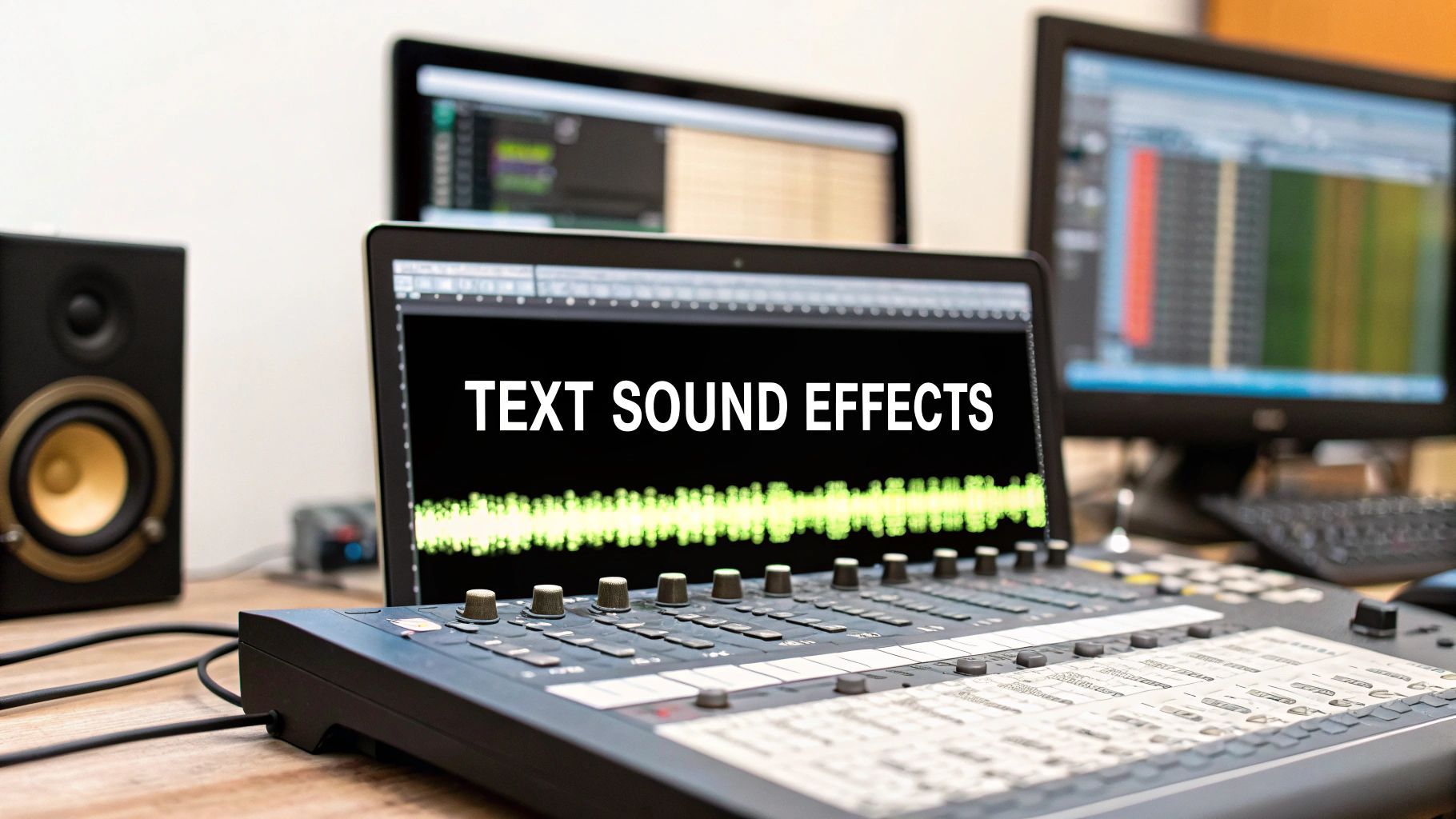
Imagine you could create any sound effect you can think of, just by describing it. That’s the reality of AI-powered text sound effects. It’s a technology that lets you instantly generate custom, high-quality audio without a foley stage or endless sound libraries. This is a massive shift from finding the right sound to creating it on the spot.
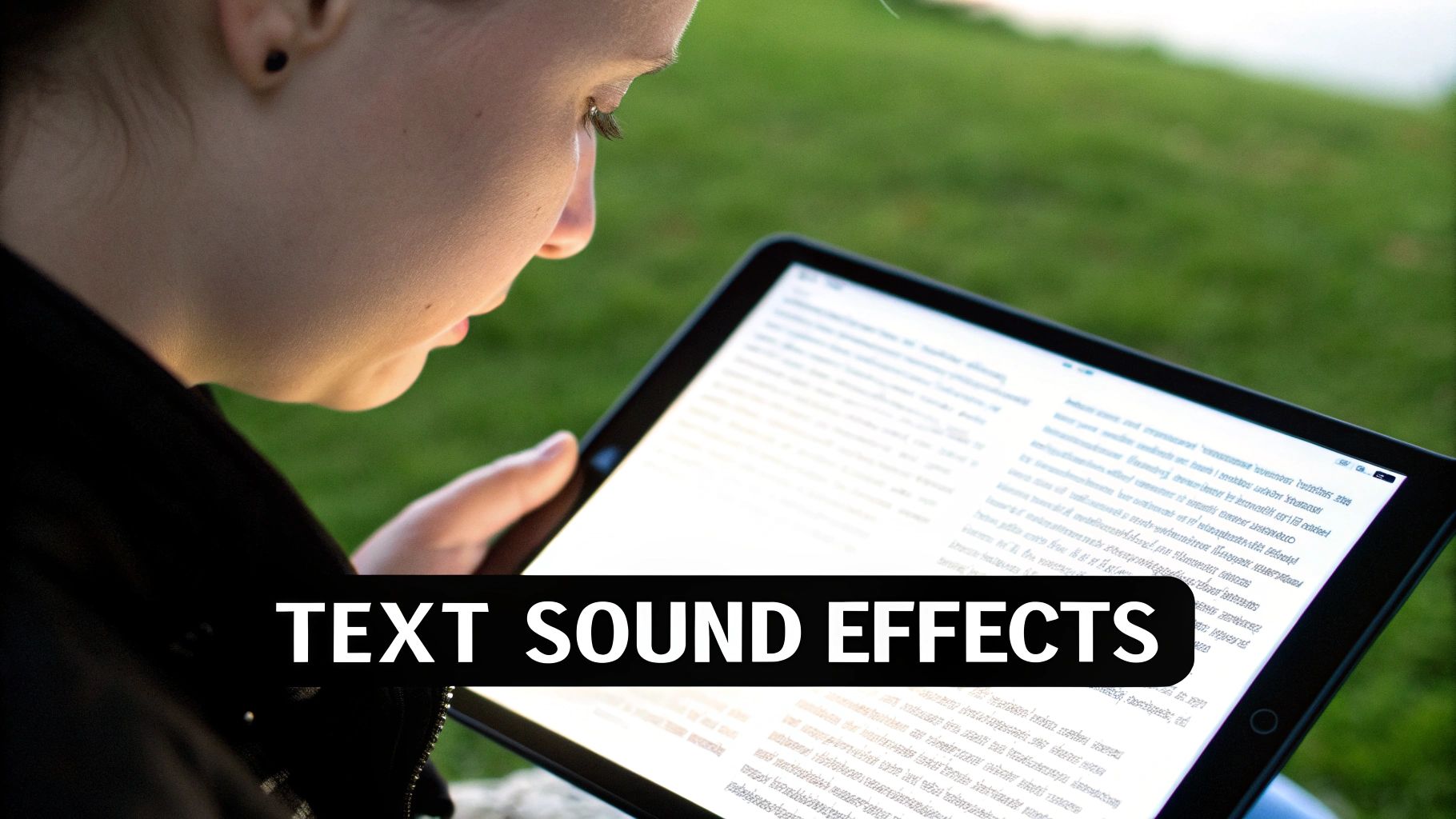
For years, creators have had to work with what's available. We've all been there—sifting through massive, pre-recorded sound libraries, hoping to find a file that mostly fits the scene. It’s a slow process that often ends with a compromise.
Text-to-sound generation flips that entire workflow on its head. It works a lot like the AI image generators you've probably seen. Instead of typing "a majestic lion roaring on a mountaintop at sunset" to get a picture, you type it to get that exact sound. This gives you incredible creative freedom, turning a simple description into a detailed, layered audio clip.
This isn't just a cool gimmick; it's a practical tool that solves a real-world problem for filmmakers, podcasters, game developers, and social media creators. The ability to generate the perfect sound on the fly is changing everything.
The advantages are pretty clear:
This technology lets creators get back to the art of what is sound design instead of getting bogged down in the logistics of finding files. It closes the gap between your creative vision and the final product.
Ultimately, getting good at creating text sound effects gives you far more control over your projects. This guide will take you from the basics to more advanced techniques, giving you the skills to generate professional-sounding audio for any project.
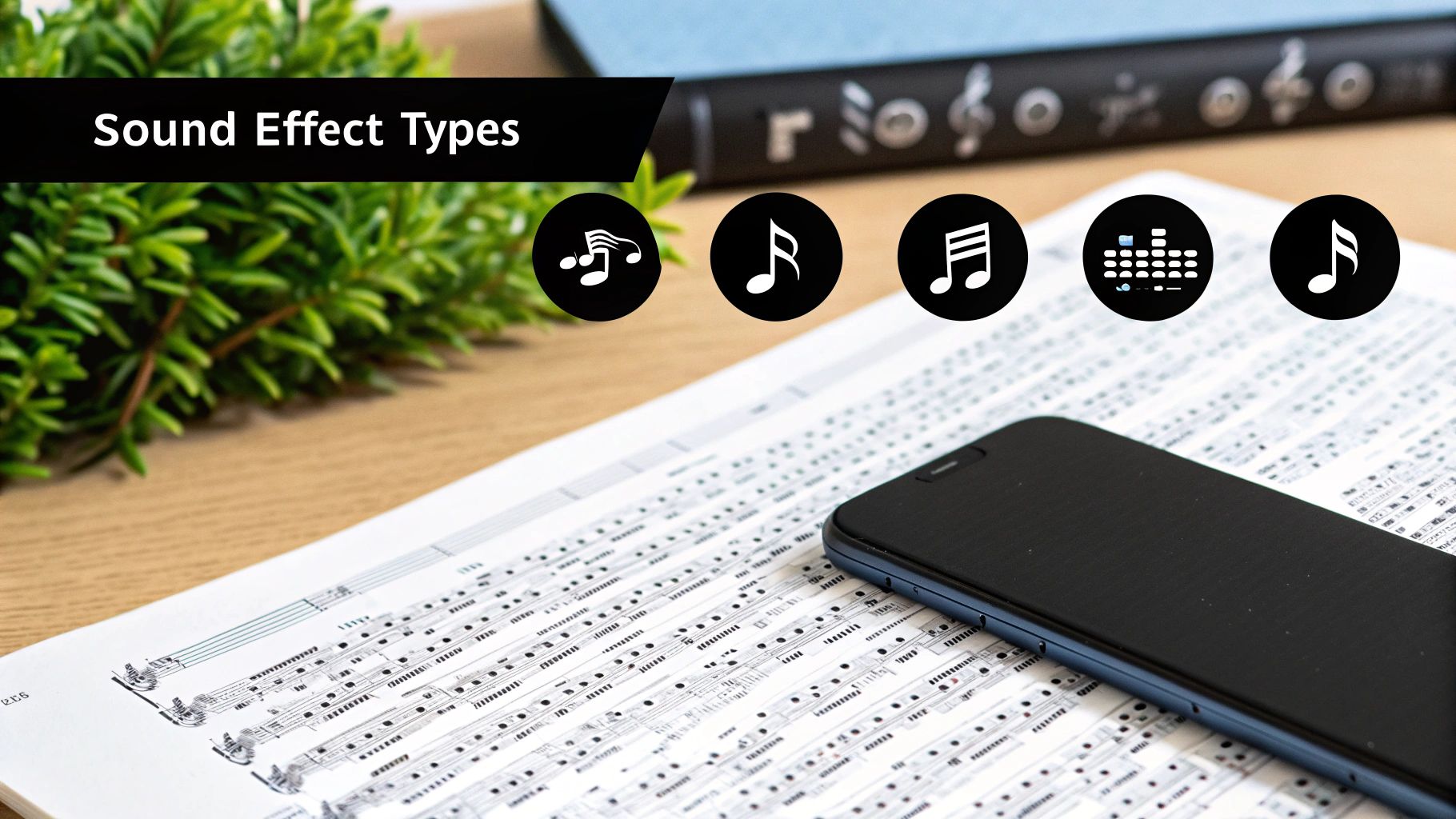
So, how does an AI turn a simple phrase into a rich, believable sound? Imagine a sound engineer who has spent a lifetime listening to literally millions of hours of audio. This AI has studied everything—from the soft pitter-patter of rain on a window to the deafening roar of a sold-out stadium. And for every sound it heard, it also read a detailed text description. This gigantic library of sound-and-text pairs is its training ground.
When you type in a prompt like "a heavy wooden door creaking open," the AI doesn't just rummage through a folder to find a pre-made sound file. It’s far more clever than that. It acts like a composer, instantly recalling all the sonic qualities it associates with words like "heavy," "wooden," "creaking," and "door." It then blends these separate audio concepts into a brand-new, completely unique sound that perfectly matches your description.
The whole process hinges on breaking sound down into its most basic elements. The AI has learned to identify and rebuild these core components based on the descriptive words you give it.
You can think of any sound as a recipe with a few key ingredients. The AI has learned precisely how to mix these ingredients based on your text prompts, paying close attention to three main acoustic properties:
By mastering these elements, the AI can construct a convincing soundscape from scratch, just from your words.
The real magic is in the synthesis. The AI isn't just playing back a recording; it's performing an act of digital creation, generating a sound that has never existed before but perfectly matches your creative intent.
This deep grasp of audio fundamentals allows for incredible control and detail. While we're talking about sound effects here, the same core principles—an AI translating text into sound waves—are at play in many modern systems, including those behind leading Text-to-Speech (TTS) API providers. Both technologies depend on a model’s ability to understand language and reconstruct it as audible sound.
Once you understand this foundational process, you're in a much better position to write effective prompts. Knowing the AI is listening for cues about timbre, pitch, and environment helps you move beyond basic descriptions. You can start crafting truly bespoke audio with real purpose and control, turning you from a casual user into a skilled sound creator.
Generating truly great text sound effects isn't about some hidden technical skill; it's about learning the art of the perfect prompt. Think of it like you're a film director guiding a sound artist—in this case, an AI. The more vivid and precise your direction, the better the final performance. If you give a vague command, you'll get a generic result. But a beautifully crafted prompt? That can produce the exact sound you're hearing in your head.
The real secret is learning to break down your sonic idea into its essential parts. A powerful prompt doesn't just name a sound; it paints a complete audio picture for the AI. By layering in specific details, you go from a simple description to a rich, evocative soundscape that can elevate any creative project.
Every great sound prompt is built on four core elements. When you combine them, you can guide the AI with almost surgical precision, making sure the audio it creates is exactly what you envisioned. Getting these pillars right is the first step to creating genuinely custom audio. If you want to dive even deeper, our guide on how to create sounds offers some extra tips.
Let's break down the anatomy of a perfect prompt:
When you consciously combine these four pillars, a simple idea quickly becomes a powerful, specific command.
Think of a prompt as a recipe, not just a request. You provide the ingredients—subject, adjectives, action, and environment—and the AI cooks them up into a finished sound. The better your ingredients, the better the final dish.
This simple workflow shows how you can put these steps into practice, from your initial idea to the final export.
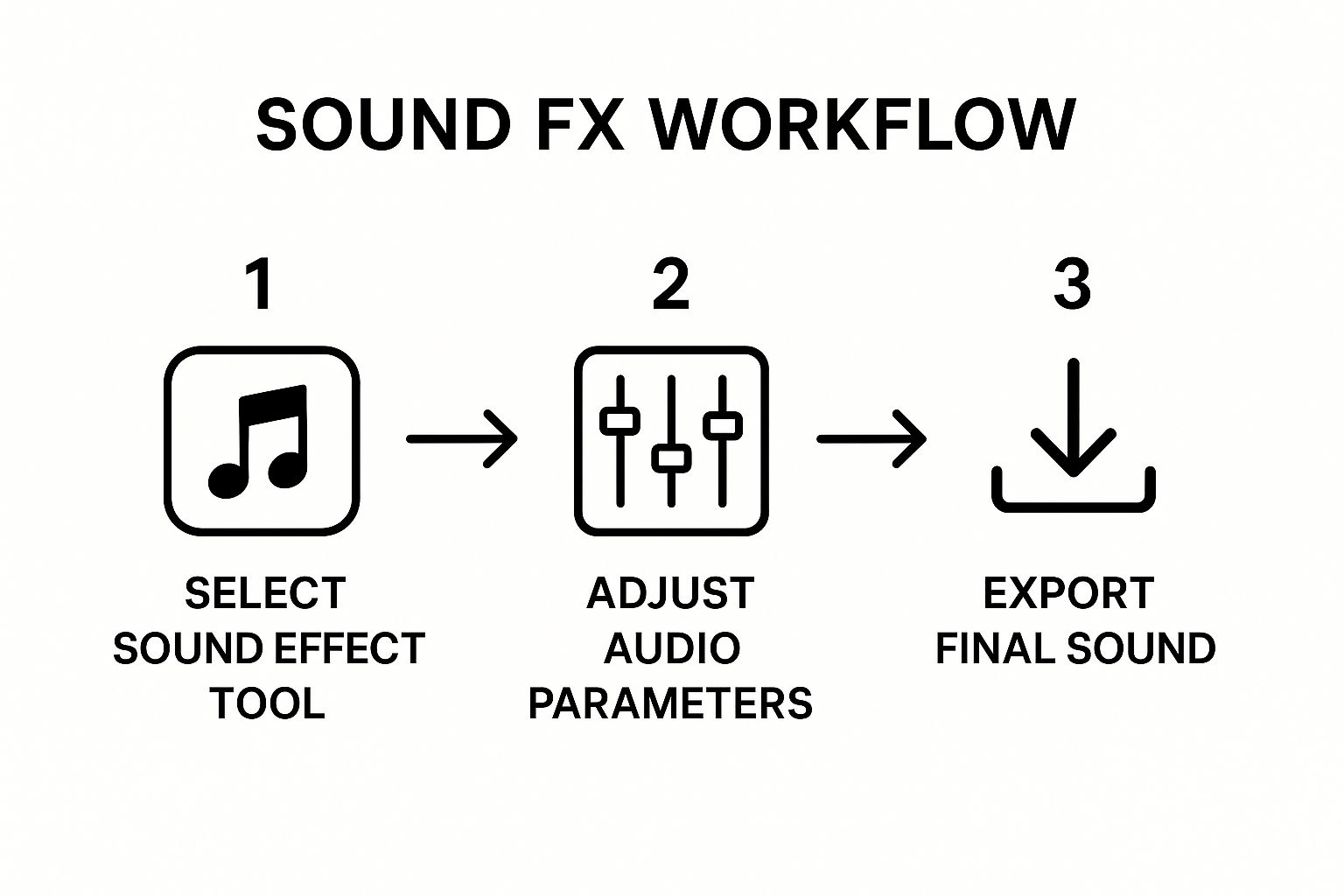
As you can see, the process creates a clear path from picking your tool to exporting the final audio file, highlighting how important it is to tweak and refine your prompt along the way.
To show you what I mean, let's look at an example. A beginner might just type "wind blowing." It’s not wrong, but it gives the AI almost nothing to work with. Now, let's apply our four pillars and build on that idea: "a lonely gust of wind whistling through the cracks of an abandoned wooden cabin window." See the difference? The second prompt tells a story.
The resulting text sound effects will be infinitely richer, more specific, and more interesting. That’s the difference between just finding a generic sound effect and creating a bespoke piece of audio art.
The table below really drives home how adding layers of detail can transform a prompt from basic to brilliant, giving you far more control over the final sound.
| Prompt Element | Simple Prompt Example | Specific Prompt Example |
|---|---|---|
| Subject | Footsteps | Heavy leather boots |
| Action | Walking | Slogging through thick mud |
| Descriptors | N/A | Slow, squelching, labored |
| Environment | Outside | On a swampy path at night |
| Final Prompt | "Footsteps walking" | "Slow, squelching, labored slogging of heavy leather boots through thick mud on a swampy path at night." |
As you can see, the "Specific" prompt provides a complete sonic scene. This level of detail is what unlocks the AI's potential to generate truly compelling and unique audio.
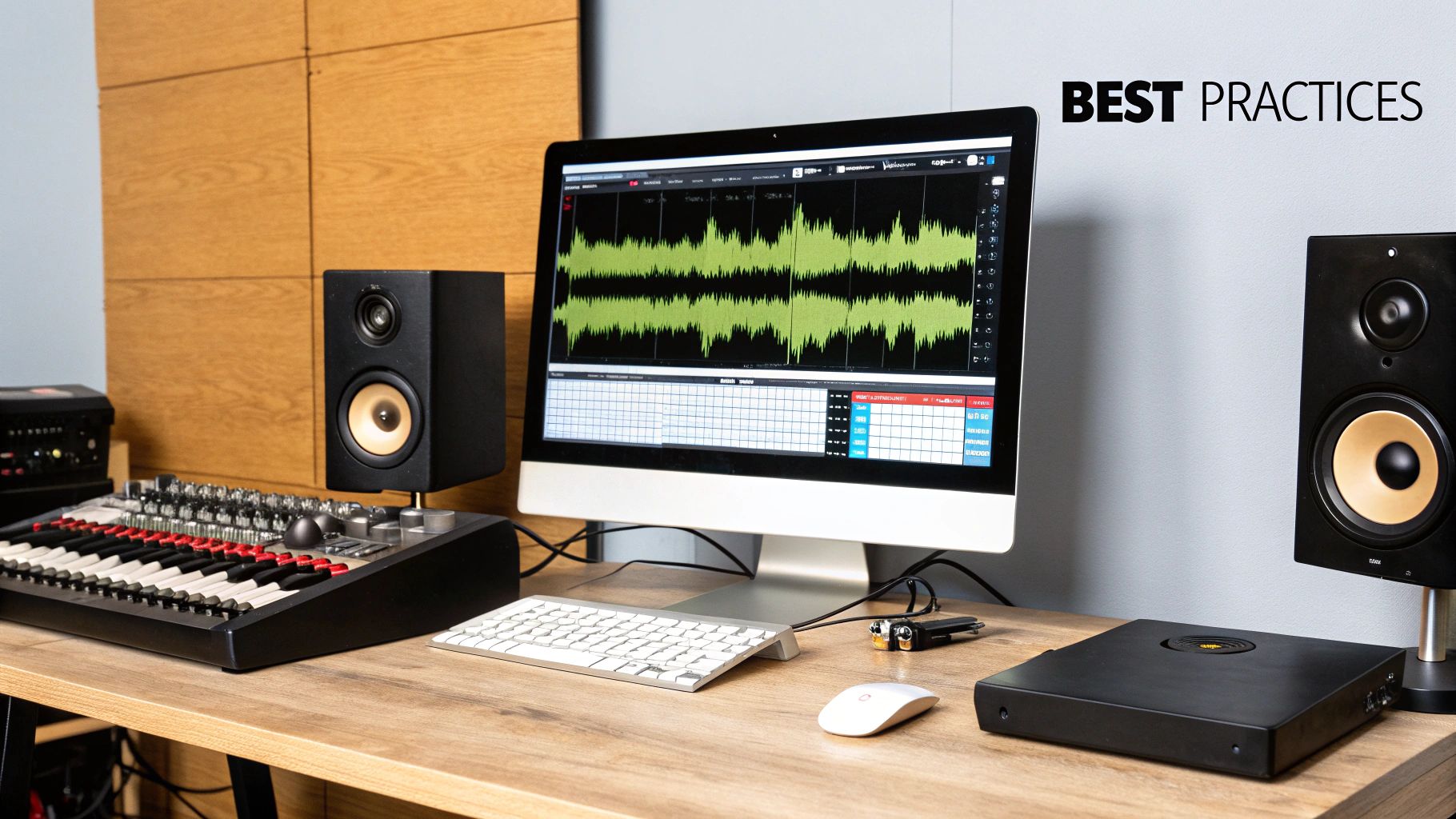
Knowing how to write a good prompt is one thing. Seeing how other creators are actually using text sound effects in their projects? That's where the real magic happens. This isn't just a fun novelty anymore; it's quickly becoming a go-to tool in professional workflows everywhere.
Whether it’s for adding a subtle atmospheric touch or creating a bold, unmissable sound cue, AI is fundamentally changing the sound design game.
Take filmmakers and podcasters, for instance. Instead of digging through a sound library for a generic "forest ambience" track, a creator can now just type in "a quiet pine forest at dusk with a gentle breeze and distant crickets." That kind of specificity makes it so much easier to build a believable, immersive world for the audience.
The ripple effect is being felt in any industry where unique audio is a big part of the user experience. Game development and UI design are two fields that are already seeing a huge upside.
The big shift here is moving from searching for a sound that works to creating the exact sound you need. It empowers you to match the audio perfectly to your vision, instead of settling for "close enough."
This is all part of a much bigger trend. The synthetic voice market, a close cousin to text sound effects, was valued at roughly USD 1.78 billion in 2024. By 2034, it’s projected to hit nearly USD 23.4 billion. That explosive growth is being fueled by the entertainment and gaming industries, which accounted for over 53.6% and 42.3% of the market, respectively. You can find out more about what this means for digital media over at https://sfxengine.com/blog/free-ai-audio-generator.
Whether you’re a seasoned pro or just messing around, the possibilities are endless. Using a free AI audio generator is a great way to start playing with these ideas without spending a dime.
Here are a few real-world scenarios to get your gears turning:
At the end of the day, the power of text sound effects is its ability to turn a creative thought directly into a usable audio file. It speeds up workflows and opens up a whole new world of artistic options for creators everywhere.
Once you have a feel for the basic prompt structure, you can start getting a lot more creative. Think of it less like giving a single command and more like being a sound architect, carefully designing every element. This is where you go from generating simple noises to creating nuanced, complex, and professional-grade text sound effects that bring your vision to life.
It's all about strategic intent. You'll learn to layer instructions, tweak outputs on the fly, and understand how even the smallest word change can shape the final sound. Each prompt becomes a step in a larger process, giving you a level of control that a simple sound library just can't match.
One of the most powerful tools in your kit is the negative prompt. This is where you tell the AI what you don't want to hear. It’s a lot like sculpting—you're not just adding clay, you're carving away the excess material to reveal the perfect shape underneath.
This trick is a lifesaver when you need to clean up an environmental sound or isolate a very specific action from a noisy background.
Example 1: You prompt for "heavy rainfall," but the AI includes a clap of thunder. Not what you wanted. The fix is simple: heavy rainfall -no thunder.
Example 2: You need the sound of a lone wolf howling, but "wolf howling at night" comes back with a chorus of chirping crickets. To isolate your subject, you'd use: wolf howling at night -no crickets, -no insects.
Negative prompts give you surgical control. They help the AI zero in on the exact sound you need, stripping out distracting background noise and delivering much cleaner, more usable text sound effects.
Amazing sound design rarely happens on the first try. The secret is iteration—starting with a good foundational sound and then building on it. You can tweak the prompt to add layers, adjust qualities, or even string multiple sounds together.
Let's say you generate a "deep, menacing monster growl." It sounds good, but maybe a bit flat. For your next prompt, you could build on it: "deep, menacing monster growl, followed by a wet, gurgling snarl." That's a simple form of chaining, where you're telling a small sonic story.
Don't be afraid to experiment with synonyms and different adjectives. "Crunchy footsteps on snow" will have a completely different feel from "soft footsteps on powder snow." Every word is a tool.
To really make these advanced techniques work for you, it helps to get into a few good habits. This isn't about being rigid; it's about building a smarter, more creative process that helps you get unstuck when a prompt isn't cooperating.
Organize Your Sound Library: When you nail a sound, save the prompt that created it right alongside the audio file. You’re building a personal, searchable library of effects and the "recipes" used to make them. It’s a huge time-saver down the road.
Understand the Current Limitations: AI is incredible, but it's not magic. It can struggle with extremely dense scenes in a single prompt, like "a chaotic medieval battle with swords clashing, arrows flying, and soldiers shouting in the rain." Your best bet is to break that down. Generate the individual sounds—the sword clashes, the arrow whooshes, the shouts—and layer them yourself in your editor for maximum control.
Troubleshoot Creatively: If a prompt just isn't landing, try coming at it from a completely different angle. Instead of "a futuristic spaceship door," describe the action and materials: "a pressurized airlock hissing open with a metallic clank." Sometimes, all you need is a fresh perspective to get the perfect sound.
Jumping into AI-generated audio is exciting, but it's totally normal to have a few questions. This technology unlocks a whole new creative toolbox, but it comes with its own quirks and rules. We've rounded up the most common questions we hear to give you clear, straight-to-the-point answers, so you can start creating text sound effects with confidence.
Think of this as your quick-start guide. Getting a handle on what this tech can (and can't) do right from the beginning will make your workflow so much smoother.
The realism you get boils down to two things: how good the AI model is and how detailed your prompt is. For specific, everyday sounds, the results can be shockingly lifelike. A prompt like "a ceramic coffee mug being placed on a wooden table" will often generate a sound you can't tell apart from a real recording.
But when you get more abstract with something like "the sound of a forgotten memory," the AI isn't aiming for realism—it’s giving you an artistic interpretation. If you want sounds that feel real, you have to feed the AI specific details about the materials, actions, and the environment you're picturing.
Treat the AI like a foley artist, not a search engine. The more descriptive you are, the more believable the sound will be.
This is a big one, and the answer almost always comes down to the terms of service of the tool you're using. The good news is that many platforms, including SFX Engine, are designed for creators and offer commercial licenses that give you full rights to use the audio you generate.
Typically, these licenses come with a paid subscription or are part of a credit system. It is absolutely crucial to always check the platform's licensing agreement before you drop a generated sound into a commercial project. A quick check upfront saves you from any copyright headaches later and gives you total peace of mind.
AI sound generation is powerful, but it's not magic. It's important to know its current boundaries. Most models are fantastic at creating short, distinct, high-quality sound effects. They're perfect for one-off foley sounds, UI clicks, or specific background elements.
Where the technology is still catching up is in creating complex, layered soundscapes from a single prompt. For example, trying to generate an entire "chaotic medieval battle scene" with swords clashing, arrows flying, and soldiers shouting all at once is still a big ask. Likewise, creating very long audio tracks, like a full song or an hour-long ambient loop, is a feature that's still on the horizon for most tools.
The core difference is creation versus curation. A traditional sound effects library is a fixed collection of pre-recorded clips. You have to hunt through it, hoping to find something that's "close enough" for what you need, which almost always means making a compromise.
AI text sound effects generation flips that script entirely. It creates brand-new, unique audio from scratch, just for you. This means you have practically unlimited creative freedom. You can conjure up hyper-specific sounds—like "a rusty iron gate creaking open in a windy graveyard"—that would be next to impossible to find in a regular library, giving your project a truly custom feel.
Ready to stop wondering and start creating? SFX Engine lets you generate custom, royalty-free sound effects with just a few words. Sign up for free and hear the difference for yourself. Generate Your First Sound Effect on sfxengine.com